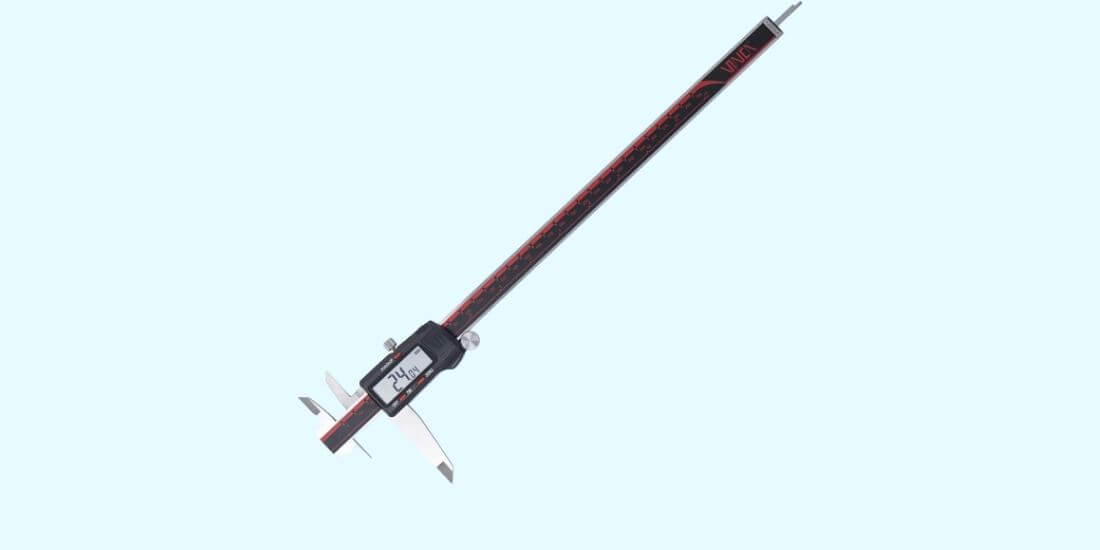Calipers are measuring instruments used to precisely measure the distance between two opposite sides of an object that cannot be easily measured using a ruler or any other measuring instrument.
A digital caliper has a series of capacitance sensors and an LCD window for reading and displaying measurement. Digital calipers are easier, convenient, and accurate measuring instruments.
Digital calipers are also known as electronic calipers. They are used to take inside and outside measurements using the internal and external measuring jaws, depth/height measurements using the depth rod, and step measurements.
Digital calipers are highly accurate (30 to 40 ᄉm) with a resolution of 10 ᄉm. The high performance of digital calipers is due to the multi-plate capacitive sensors.
Capacitive sensors are linear, simple, and rugged proximity sensors that create an electrical field to detect nearby objects. Capacitive sensors are not affected by mechanical and electronic noise.
One of the downsides of electronic calipers is their sensitivity to liquids. Because the sensors rely on capacitance, their capacitance increases if they come in contact with any liquid.
The technology of digital calipers is relatively new; therefore, not many people know digital calipers work. This article is dedicated to perpetuating the knowledge about digital calipers and how they work.
The Working Principle of Digital Calipers
Stator
This is a thin strip of material fixed on the main body of the instrument. The material is an etched circuit board that carries a linear electrode array.
The electrode array on the stator alters the signals produced by another array attached to the slider.
Slider
The slider has two sets of electrodes making the slider array. The two electrodes face the electrode on the stator.
However, the electrodes on the slider and the stator do not come into contact. One of the slider’s electrodes carries a sine signal while the other carries a cosine signal.
Detectors
Slider electrodes produce sine and cosine signals of frequency 100kHz, which the stator electrode then alters.
The two detectors on the slider detect the altered signal produced by the stator electrode and produce accurate information on the position and direction of the slider.
Computer
It decodes the position and direction information of the slider into measurement readings either in millimeters or inches before appearing on the LCD display.
How to Use A Digital Caliper
- Depending on the dimensions you intend on measuring, place either the internal or external jaws on the object
- Tighten the jaws using the thumb screw so they touch the object you are measuring
- Displacement of the jaws causes a change in the electrical capacitance which is detected by the sensors in the slider and stator
- A signal is then sent to a chip within the caliper that contains position and direction information
- The computer chip in the decodes the information into measurement reading
- Read the measured valued shown on the LCD display
Advantages of a Digital Caliper
- Digital calipers are highly accurate, they can measure up to 0.01 mm
- Reading measurements on digital calipers is easy due to the LCD display
- Digital calipers are made from stainless steel and titanium which are durable materials making the instrument shock proof and able to withstand wear and tear for an extended period
- Digital calipers can display measurements in metric and imperial format
- The zero button on digital calipers makes it easy to take comparative measurements or recalibrate
Disadvantages of a Digital Caliper
- Digital calipers are sensitive to moisture and dampness even though most of them are water resistant.
- Similarly, electronic calipers can be affected by a magnetic field resulting in erroneous readings.
- Digital calipers are battery powered; therefore, you need spare batteries
- Electronic calipers are sensitive to dirt which can lead to errors, same case with extreme weather conditions.
That’s How Digital Calipers Work
A digital caliper, also known as an electronic caliper, is a precision instrument used to accurately measure the internal and external distance that cannot be easily measured using a ruler or other measuring instruments.
Digital calipers are a recent innovation in caliper technology.
Unlike dial and vernier calipers that use a rack and pinion mechanism, digital calipers use multi-plate capacitive sensors in the stator and slider to detect changes in electrical change/capacitance once the jaws of the calipers are moved.
The slider has a pair of electrodes, one carrying a sine signal while the other carries a cosine signal.
The stator has a linear electrode that alters the signals from the slider electrodes.
The detector picks up the altered signal to produce position and direction information.
A chip within the caliper then deciphers the position and direction and converts it into a reading shown on the LCD window.
-
A diode is an electronic component with two leads or terminals – a cathode and…
-
Checking, repairing, and designing a circuit is a simple task if you have a multimeter.…
-
A digital caliper is a useful tool in any workman’s kit. Anyone who has worked…
-
In metal working, accuracy and simplicity are two of the most important factors. That is…
-
Resistors are electrical components that have resistance to the flow of electric current. They are…
-
DIY electronic projects are great and enjoyable. As a beginner, you can be a little…
-
It takes you straightforward steps to change a multimeter battery. When you have found out…
-
This is a public or personal two-way radio service affected by various factors that can…



